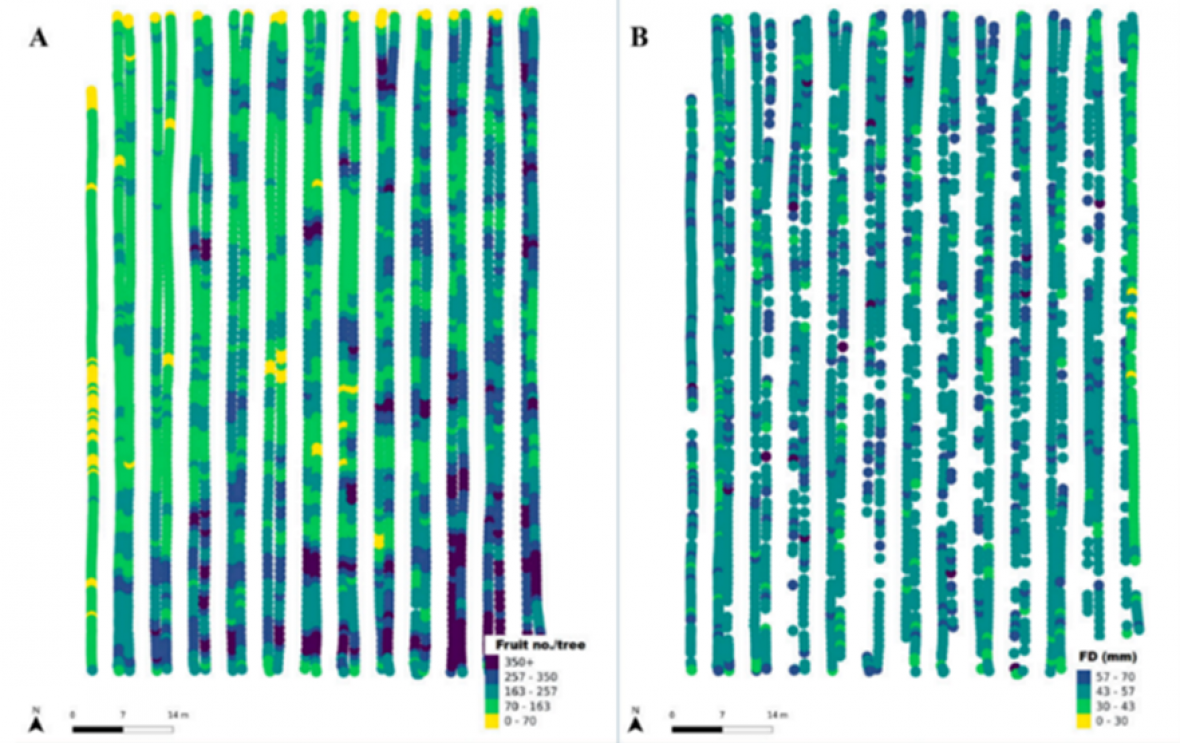Modern Summerfruit orchard production systems are geared to improve yield and packout performance via optimal crop load and uniformity in tree canopy architecture for high-quality fruit and efficient light interception and distribution.
Flower and fruit thinning are important orchard management practices in commercial Summerfruit production. The standard industry practice for crop load management adopts flower thinning at bloom and/or post-bloom fruitlet thinning preceded by winter pruning to establish tree fruiting units and optimal canopy architecture. Thinning early in the season, before cell division of fruits is complete, supports maximum carbohydrate availability, high yield and improved fruit quality.
Methods for bloom thinning include mechanical machinery (e.g., Darwin string thinner, Eclairvale), chemical (e.g., ATS) and manual hand thinning of flowers. Fruitlet thinning practices include manual hand thinning fruit and mechanical machinery. Combining thinning approaches (e.g., chemical blossom with mechanical fruitlet thinning) reduces the dependence of expensive hand thinning costs.
Precision crop load management is essential for good fruit quality. Fruit quality (size, maturity, colour, shape) and return bloom are closely linked to crop load. On a tree-by-tree basis within an orchard block, the more uniform fruit number per tree (and tree size) the easier it is for crop load management intervention (e.g., blossom, fruitlet thinning) and associated gains in improved crop value (i.e., marketable yield).
Precision orchard management adopts the approach that employs advanced technology and data analysis — known as Agriculture 4.0 — to maximize productivity, reduce waste, increase production efficiency and optimise resource use (i.e., labour, nutrients, water, crop protectants). Nowadays, technology can measure blossom, fruit and tree features to provide high-resolution (tree scale) maps of orchards. These orchard scans of crop, fruit and canopy provide the backbone for distribution histogram analysis and precision zonal maps for variable rate management practices of crop load (fruit number per tree), tree size, potential yield and fruit quality (size, colour).
Example case studies on spatial variability (within-orchard) scans of fruit number and fruit size in commercial Summerfruit orchards are shown in Figure 1. Here, world-first studies for Summerfruit crops by Agriculture Victoria have shown in peach, nectarine and plum, high spatial variability in fruit number (coefficient of variation, CV = 30 – 47 %), while fruit diameter (CV = 10 – 12 %) and fruit colour (CV = 5 – 7 %) were more uniform. To date, no known examples in the literature exist on tree-scale sensing of blossom loads in Summerfruit crops. From a horticultural perspective, such spatiotemporal variability as shown in Figure 1 highlights the need for precision orchard management and potential large gains in orchard efficiency and improved crop value.
 Figure 1. Precision orchard scans at harvest of crop load (fruit number per tree) and fruit diameter (mm) using a mobile sensing platform in a commercial plum orchard in Ardmona, Victoria.
Figure 1. Precision orchard scans at harvest of crop load (fruit number per tree) and fruit diameter (mm) using a mobile sensing platform in a commercial plum orchard in Ardmona, Victoria.
Agriculture Victoria’s Mark O’Connell says the new research project (SF23000 Precision Summerfruit Orchards) aims to align tree-specific spatial data to inform precision orchard management decision making and agronomic intervention strategies such as zonal tree pruning, flower and fruit thinning and has flow-on implications for pest and disease spraying, nutrient and water management, and harvest logistics. Here, improvements in uniformity of fruit number, fruit size and tree size provide for increases in yield and packout outcomes, offer large gains in production and labour efficiency (e.g., pruning, spraying, harvesting) and are aligned to new developments in mechanisation and robotics of orchard management.
Precision orchard technology being evaluated by project SF23000 includes mobile ground-based (Green Atlas Cartographer), airborne (Outfield Technologies Orchard Management Platform - drone) and handheld (Aerobotics, Hectre, Croptracker smartphone APPs, Bluetooth digital calipers) sensing systems. These tools and platforms offer a cost efficient and rapid approach to capture real-time tree-scale data on fruit and tree metrics. For example, leading apple growers in the Goulburn and Yarra Valleys have adopted orchard scans of crop, fruit and canopy to provide precision zonal maps to inform variable rate orchard management practices (e.g., pruning, thinning, leaf blowing, fertiliser).
In summary, optimal crop loads and favourable canopy light conditions provide the foundation for high marketable yields. Precision crop load management for Summerfruit orchards is now possible with new technologies and will be tested and evaluated as part of this project.

Acknowledgement
Precision Summerfruit Orchards (SF23000) has been funded by Hort Innovation, using the Summerfruit research and development levy, contributions from the Australian Government and co-investment from Agriculture Victoria. Hort Innovation is the grower-owned, not-for-profit research and development corporation for Australian horticulture.
